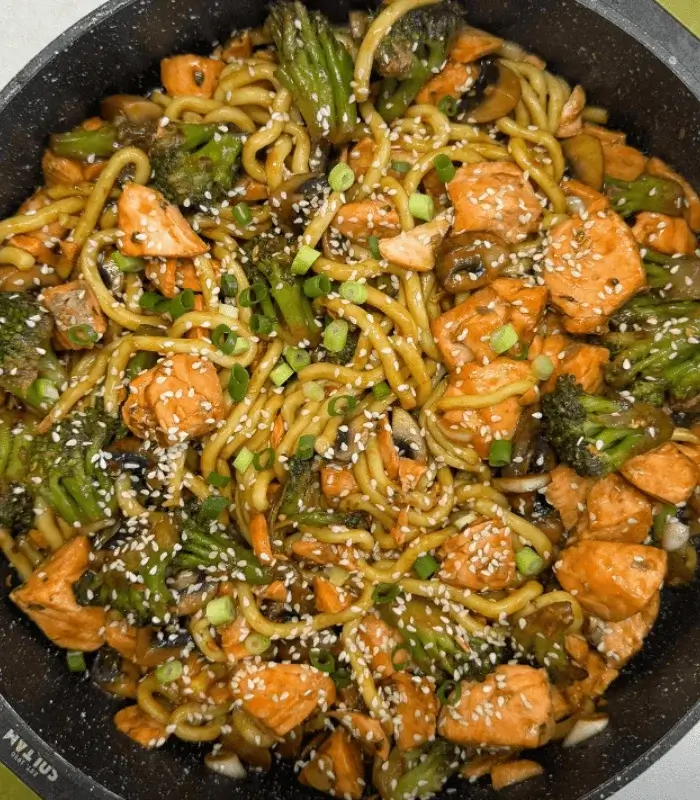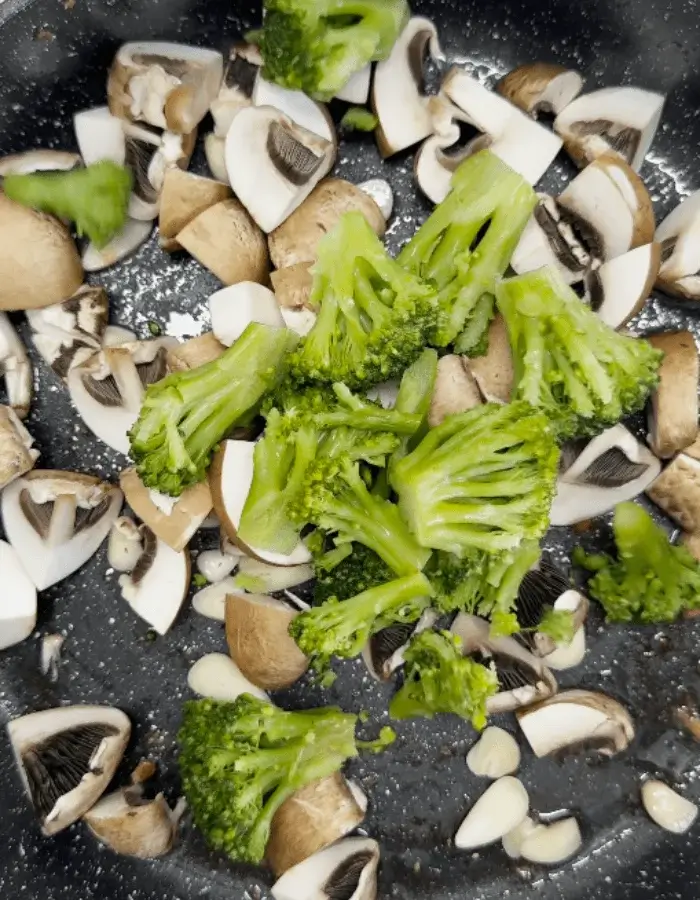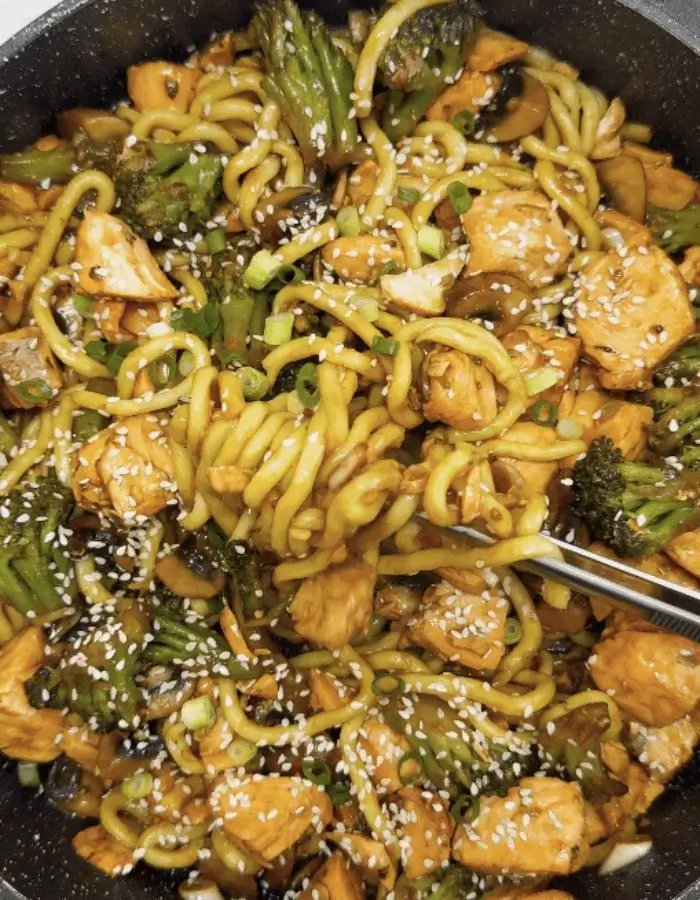Quick Salmon Stir Fry with Noodles and Broccoli
We may earn a commission from recommended products, at no extra cost to you. See Disclosure.
- Chef's knife
- Wide sauté pan or wok
- Tongs or wooden spoon
INGREDIENTS
- 14 ounces/400 grams fresh salmon, cut into cubes
- 14 ounces/400 grams frozen broccoli florets
- 9 ounces/250 grams fresh mushrooms, sliced
- 4 garlic cloves, thinly sliced
- 14 ounces/400 grams ready-to-eat noodles
Sauce:
- ½ cup teriyaki sauce
- ¼ cup sweet chili sauce
- 1 tablespoon soy sauce
Garnish:
- 2 green onions, thinly sliced
- 1 teaspoon sesame seeds
INSTRUCTIONS
- Place the noodles in a medium heatproof bowl and cover with hot water. Let them soak for 10 minutes, stirring occasionally to loosen the strands. Drain well and set aside.
- Heat a wide sauté pan or wok over medium-high heat. Add 1 tablespoon/15 ml olive oil. Sear the salmon cubes for 1 to 2 minutes per side until lightly browned but still pink in the center. Transfer to a plate.
- In the same pan, add the garlic and cook for 30 seconds until fragrant. Add the frozen broccoli and mushrooms. Stir-fry for 5 to 7 minutes until the vegetables are tender and most of the moisture has evaporated.
- Return the salmon to the pan along with the drained noodles. Pour in the teriyaki sauce, sweet chili sauce, and soy sauce. Using tongs or a wooden spoon, toss everything together gently until the noodles are evenly coated and the salmon is cooked through, about 2 minutes.
- Serve hot, topped with sliced green onions and a sprinkle of sesame seeds.

FAQ
How do I keep the salmon from falling apart in?
Use firm, skinless fillets and cut them into even cubes about 1 inch thick. Pat the cubes dry before cooking to help them sear and hold their shape. Use a nonstick skillet or a well-seasoned wok over medium-high heat, and avoid moving the salmon too much during searing. Cook in a single layer for about 1 to 2 minutes per side until golden. Once seared, remove the salmon and add it back at the end of cooking. This minimizes stirring and prevents the salmon from breaking apart during mixing.

Can I use canned salmon for this recipe?
Canned salmon can be used in salmon stir fry, but it will change both the texture and the preparation method. Since canned salmon is already cooked and much softer, it should be added at the very end of the cooking process, after the vegetables and noodles are done. Avoid stirring it too much, as it can easily disintegrate. While fresh salmon provides a firmer texture and better browning, canned salmon is a quicker alternative. If using canned salmon, drain it well and remove any skin and bones for best results. It’s a practical substitute, but expect a softer bite.
What vegetables go best in salmon stir fry?
Several vegetables pair well with salmon stir fry, especially those that cook quickly and offer good texture contrast. Frozen or fresh broccoli florets are a classic choice due to their firm bite and ability to hold sauces. Bell peppers, snap peas, carrots, and mushrooms also work well. Bok choy, shredded cabbage, or baby corn can be added for variety. Avoid watery vegetables like zucchini unless you’re willing to cook off the extra moisture. Cut vegetables uniformly to ensure even cooking. A mix of colors and textures makes the stir fry more appealing and balances the richness of the salmon.
What kind of noodles are best for salmon stir fry
The best noodles for salmon stir fry are ones that can hold sauce well and won’t break apart during mixing. Ready-to-eat wheat noodles, such as stir-fry udon or yakisoba, are convenient and ideal for quick meals. Rice noodles are another option, especially for gluten-free variations, but they require soaking or boiling first. Soba noodles provide a nuttier flavor and firmer bite, while lo mein-style egg noodles offer a smooth, chewy texture. Avoid overcooking the noodles before adding them to the stir fry, and add them last to avoid turning them mushy.

How long can leftover salmon stir fry be stored in the fridge?
Leftover salmon stir fry can be stored in an airtight container in the refrigerator for up to 3 days. For the best quality, allow the stir fry to cool to room temperature before sealing and storing it. Reheat gently in a skillet over medium heat or in the microwave, stirring occasionally to ensure even warming. Avoid overheating, as salmon can dry out or become tough when reheated too long. If the stir fry contains noodles, they may absorb more sauce and soften over time. Consume within three days to maintain food safety and optimal taste and texture.
Can I use frozen salmon for salmon stir fry?
Yes, provided it is thawed properly before cooking. For best texture and flavor, thaw the salmon overnight in the refrigerator or use the cold water method by submerging the sealed fillet in a bowl of cold water for about 30 minutes. Once thawed, pat the fillet dry with paper towels to remove excess moisture, then cut it into uniform cubes. Using frozen salmon is a convenient option that does not compromise the dish, as long as you avoid cooking it while still partially frozen, which can lead to uneven texture.
Can I make this salmon stir fry gluten-free?
You can make salmon stir fry gluten-free by using gluten-free noodles and substituting traditional soy sauce with tamari or a certified gluten-free soy sauce. Rice noodles or gluten-free soba are suitable replacements for wheat-based noodles. Double-check the labels on all sauces, especially teriyaki and sweet chili, as they often contain wheat or malt-based thickeners. For the vegetables and salmon itself, there are no gluten concerns. When cooking, ensure that your equipment, such as your wok or skillet, is thoroughly cleaned if it’s shared with gluten-containing meals to avoid cross-contamination, especially if serving someone with celiac disease.

